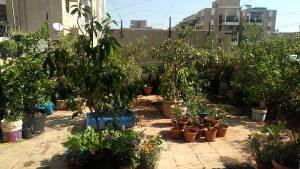
Beginners Terrace Gardening FAQs
Beginners Terrace Gardening FAQs
Are you a beginner getting into Terrace Gardening in India ?
Look no further, We have compiled few of the most Frequently Asked Questions to us as a Landscape Servicing company for Green Building Projects.

The most popular questions related to terrace gardening are listed here. Browse through it and be on your way to setting up the perfect urban rooftop garden.
We will be Constantly updating this FAQ page for Beginners & experts, to Help them Find ways to bringing fresh produce from their rooftop to the Kitchen table.
Food Tech
What is a terrace Garden?
Also called a roof garden, it is a garden in which vegetables, fruits or flowers are grown on terraces, balconies or roofs of buildings. The kitchen garden, a standard in every Indian household, has now shifted to the roof due to constraints of space and is called a terrace garden. Increasing pressure on land and escalating costs have also added to its growing popularity.
Where can one start a terrace garden?
These gardens can be created on almost all kinds of buildings like residential flats, individual houses, commercial hubs, godowns and factories.
What should be done before using the roof as a terrace garden?
A simple water proofing of the roof is enough. Various water proofing products are available in the market that will ensure that the roof is protected, water-resistant and leakage-free.
Can the roots of plants cause any harm to the building?
Plants with fibrous roots do not cause any harm to the roof but avoid plants with tap roots (like mango) as they may penetrate the roof and harm it by growing its roots in the structure. Sometimes the wind or birds may bring seeds that can germinate and take root on the roof itself. These should be checked for and removed.
How do I begin to grow food on my roof?
You can begin greening your terrace with these simple steps, and then move on to bigger ideas:
- Take any simple pot or ‘Gamla’ or better still recycle any of your old containers.
- Mix compost, soil, coir peat (or sand), and vermicompost in equal quantities.
- Cover the drainage hole at the bottom of the container with a broken pot piece or a flat stone, and fill it up with the mixture. You will have to drill a hole in a recycled container first.
- Pour water and check that no soil is discharged through the bottom hole.
- Wet the soil and plant your seed or sapling.
- Watch your greens grow!
Where can I plant in my garden?
You can start with something from your kitchen shelf, that is available and used in everyday cooking like coriander (dhaniya), fenugreek (methi), gram (chana) and chilli (mirchi). Once you gain confidence you can move onto vegetables of your choice and even grow fruit trees like banana and pomegranate. Almost all vegetables can be grown (creepers, drumstick, lime, tomatoes).
What quantity of vegetables/ fruits can I expect of my terrace garden?
You can grow at least 6 vegetables per season. Your 1 sqm of terrace area can give you anywhere between 25 to 50 kg of vegetables in a year.
Do I need any agricultural knowledge to start a terrace garden?
You don’t need any farming background to start a roof garden. It only takes enthusiasm for green living and and willingness to get your hands dirty.
What are the advantages of terrace gardens?
Some of the benefits to health, aesthetics and environment include:
- Reduce the indoor temperature by 6- 8 degrees and can reduce air conditioning cost
- Reduce overall heat absorption of buildings and insulate the building against heat and cold
- Convenience of safe, pesticide-free, healthy green and fresh vegetables
- Conducive to a routine of physical exercise, clean air and being close to nature
- Increases amount of oxygen in the air
- Reduce sound pollution
- Act as a habitat for city-weary birds
What about the maintenance of these gardens? Will they consume a lot of time?
Once your garden is established, an hour a day is more than enough to maintain your green area. It is the perfect area to exercise in and improve your fresh air intake.




Leave a Reply